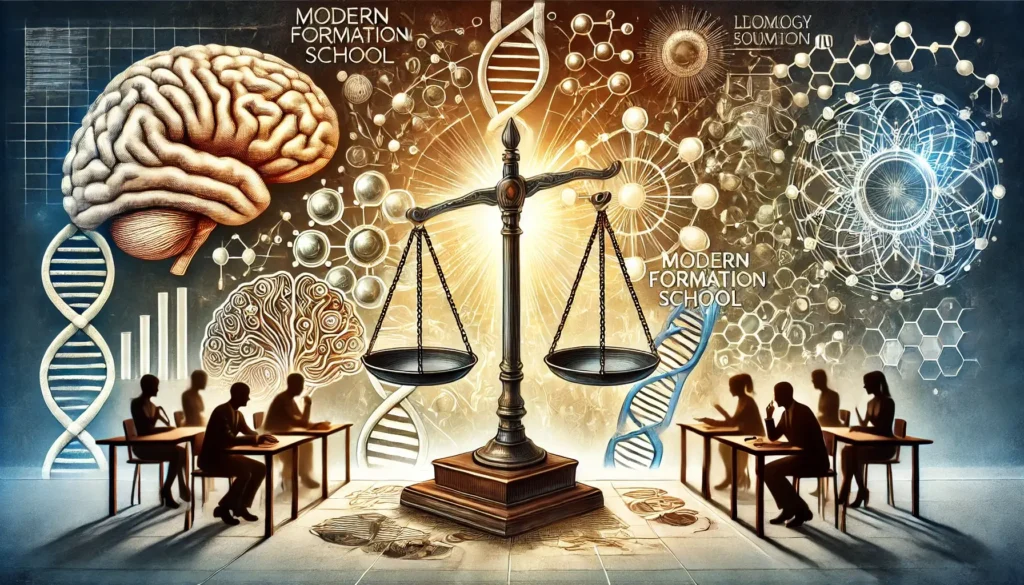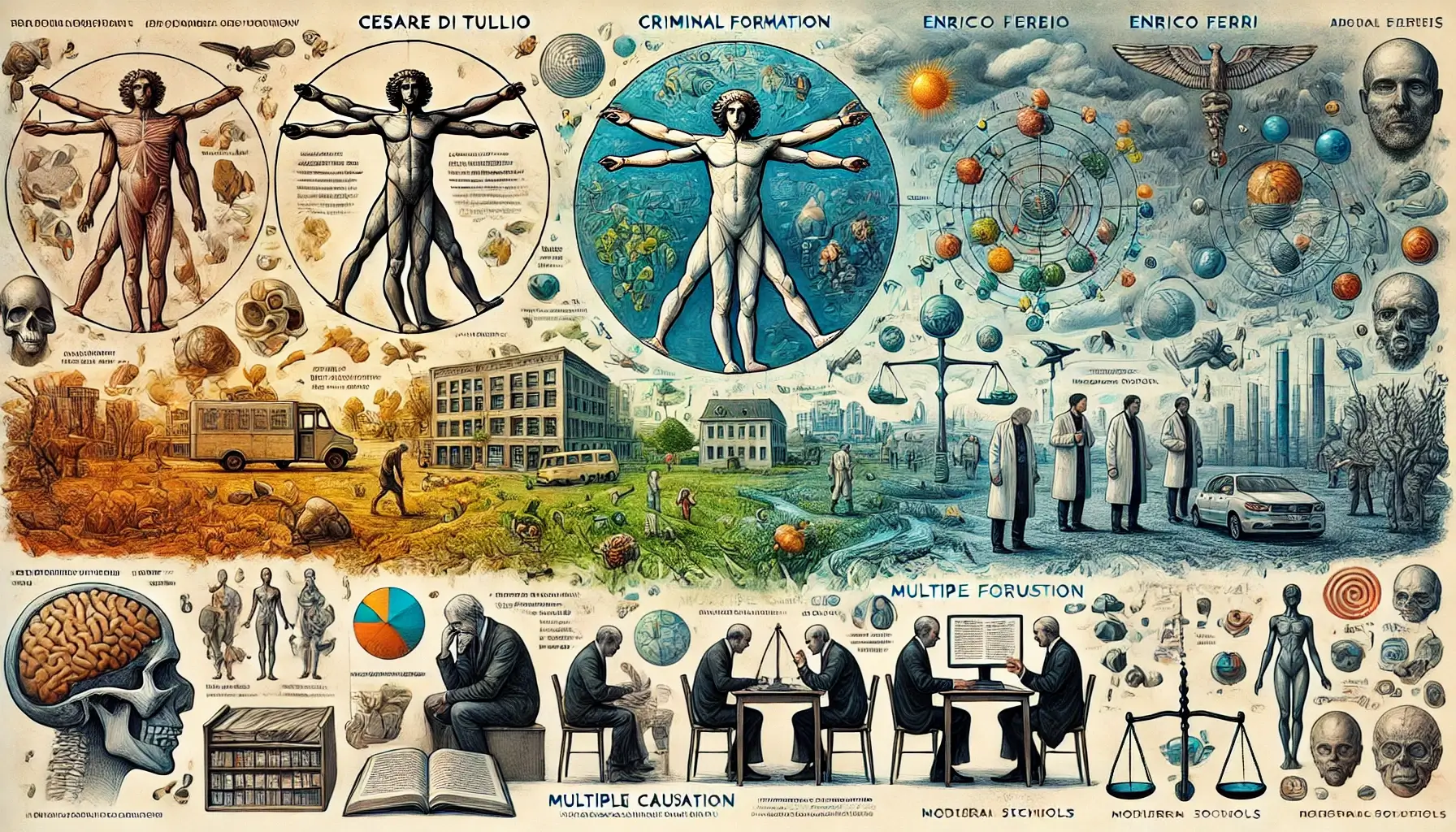The Modern Formation School in criminology represents a significant evolution in the study of criminal behavior. By emphasizing the interplay of biological, psychological, and sociological factors, this school of thought seeks to provide a comprehensive understanding of crime and its underlying causes. Within this framework, two prominent theories stand out: the Criminal Formation Theory by Di Tullio and the Theory of Multiple Causation by Enrico Ferri. This article explores these theories and evaluates the broader implications and contributions of the Modern Formation School.
Criminal Formation Theory by Di Tullio
Cesare Di Tullio, an Italian criminologist, introduced the concept of “Criminal Formation Theory” to address the intricate relationship between biological predispositions and external influences in shaping criminal behavior. Di Tullio proposed that criminal tendencies could be traced back to a combination of inherited traits and environmental pressures. This dual focus aimed to bridge the gap between earlier biological determinism and more contemporary sociological perspectives.
Key Components of Di Tullio’s Theory
- Biological Predisposition: Di Tullio argued that genetic and physiological factors could predispose individuals to criminal behavior. Traits such as impulsivity, aggression, or low tolerance for frustration were seen as potential indicators.
- Environmental Influences: While acknowledging biological predispositions, Di Tullio emphasized that environmental factors such as poverty, lack of education, and peer influence played a critical role in either mitigating or amplifying these tendencies.
- Preventative Measures: One of Di Tullio’s significant contributions was advocating for early intervention strategies. He believed that identifying and addressing risk factors in childhood could significantly reduce the likelihood of criminal behavior later in life.
Impact on Modern Criminology
Di Tullio’s theory contributed to the shift toward a multidisciplinary approach in criminology. By integrating insights from biology, psychology, and sociology, he laid the groundwork for a more nuanced understanding of crime and its prevention. His work also influenced the development of rehabilitative programs focusing on both individual and societal factors.

Theory of Multiple Causation by Enrico Ferri
Enrico Ferri, another luminary in the field of criminology, expanded upon earlier theories with his “Theory of Multiple Causation.” Ferri rejected the simplistic view that crime could be attributed to a single cause, instead advocating for a holistic approach that considered a wide array of factors.
Core Principles of Ferri’s Theory
- Multifactorial Analysis: Ferri identified three primary categories of factors contributing to criminal behavior:
- Physical Factors: These include geographical and climatic conditions, such as extreme temperatures or natural disasters, which Ferri believed could influence crime rates.
- Anthropological Factors: Personal characteristics, including genetic traits, mental health, and physical constitution, were central to this category.
- Social Factors: Ferri emphasized the role of economic conditions, cultural norms, family dynamics, and education in shaping behavior.
- Integration of Factors: Ferri argued that these elements did not operate in isolation but interacted in complex ways to influence criminal behavior. For example, a predisposition to aggression might be exacerbated by socioeconomic hardships or cultural acceptance of violence.
- Practical Application: Ferri’s approach emphasized the importance of addressing all contributing factors to prevent crime effectively. This included advocating for reforms in education, housing, and employment opportunities to reduce societal inequalities.
Influence on Criminal Policy
Ferri’s theory had a profound impact on criminal justice policies. By highlighting the multifaceted nature of crime, he inspired the adoption of integrated strategies that combined punitive measures with social reforms. His work also encouraged the development of crime prevention programs tailored to specific communities and demographics.

Evaluation of Modern Formation School’s Ideas
The Modern Formation School has garnered both acclaim and criticism for its comprehensive approach to criminology. Below, we evaluate its strengths and limitations.
Strengths
- Interdisciplinary Approach: One of the primary strengths of the Modern Formation School is its integration of diverse disciplines. By combining biological, psychological, and sociological perspectives, it provides a well-rounded understanding of criminal behavior.
- Focus on Prevention: Both Di Tullio and Ferri emphasized the importance of preventative measures, shifting the focus from punishment to rehabilitation and early intervention.
- Adaptability: The theories within this school are flexible and can be applied to various cultural and societal contexts, making them relevant across different regions and time periods.
Limitations
- Complexity in Implementation: While the multifactorial approach is theoretically sound, it can be challenging to implement in practice due to the need for extensive resources and collaboration among various sectors.
- Potential for Misinterpretation: The emphasis on biological factors has occasionally led to misinterpretations that echo outdated notions of determinism, potentially stigmatizing certain individuals or groups.
- Need for Empirical Validation: Some aspects of the theories require further empirical research to substantiate their claims fully.
Modern Relevance
Despite these challenges, the Modern Formation School continues to influence contemporary criminology. Its principles are evident in current efforts to address crime through community-based programs, mental health initiatives, and socioeconomic reforms. By recognizing the interconnectedness of various factors, this school offers a robust framework for tackling the complexities of modern criminal behavior.

Conclusion
The Modern Formation School in criminology represents a pivotal shift toward understanding crime as a product of multiple interrelated factors. Through the groundbreaking contributions of Cesare Di Tullio and Enrico Ferri, this school has laid the foundation for a more nuanced and effective approach to crime prevention and rehabilitation. By continuing to refine and expand upon these ideas, criminologists and policymakers can work toward a more equitable and just society.

